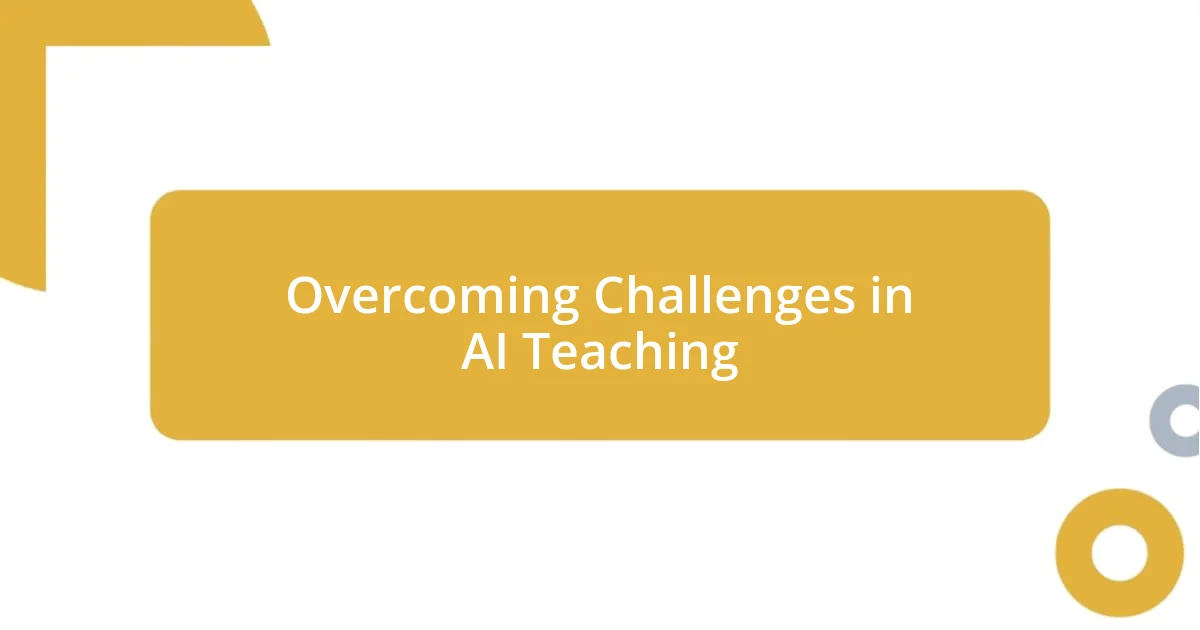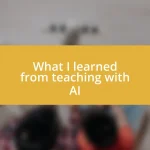Key takeaways:
- AI enhances personalized learning experiences, allowing for tailored feedback and resources that cater to individual student needs.
- Integrating AI in classrooms increases student engagement through interactive learning, instant feedback, and collaborative projects, making education more immersive.
- While AI presents opportunities for innovative teaching, challenges such as maintaining personal connections and addressing data privacy must be carefully managed.

Understanding AI in Education
When I first started integrating AI into my teaching, I faced a mix of excitement and apprehension. I wondered, could AI truly enhance learning or would it simply complicate things? My initial skepticism turned to fascination when I saw how AI could personalize learning experiences for each student. It was incredible to witness tailored feedback that not only addressed individual strengths but also gently guided students through their challenges.
One day, a student of mine expressed frustration with a particular math concept, feeling overwhelmed by the standard pace of the curriculum. Using AI-driven tools, I was able to provide adaptive resources that adjusted based on her understanding. Seeing her confidence grow, I couldn’t help but reflect: how often do we overlook the potential of technology to meet students where they are? It was a powerful reminder of how vital it is to embrace innovative methods that resonate with diverse learning styles.
AI doesn’t just transform how we teach; it reshapes our understanding of knowledge itself. I remember a moment in class when we used an AI tool for a science project, and the excitement among students was palpable. They weren’t just learning; they were exploring, searching for answers together in a way that felt more like a collaboration than traditional education. Isn’t that what we want for our students? An opportunity to engage, collaborate, and foster curiosity in a world that is increasingly driven by technology?

Enhancing Student Engagement with AI
In my experience, using AI tools has completely transformed the way students interact with the learning material. One day, I integrated an AI platform that gamified our history lessons. The moment students became avatars in a virtual quest to uncover historical events, I saw engagement soar. They didn’t just absorb facts; they immersed themselves in the narratives, making connections they hadn’t before, and it was inspiring to watch them discuss and debate topics with such enthusiasm.
Here are some ways AI has enhanced student engagement in my classroom:
- Interactive Learning: AI can create simulations and scenarios that enhance critical thinking.
- Personalized Pathways: It provides individualized pathways that cater to different skill levels, helping students feel valued.
- Instant Feedback: Real-time responses on assignments encourage students to take ownership of their learning.
- Collaborative Projects: AI enables group work by facilitating communication and project management online, increasing teamwork skills.
- Data-Driven Insights: By analyzing student performance data, I can identify who needs support, allowing for timely interventions.
Overall, I’ve witnessed firsthand how these elements not only boost engagement but also foster a genuine love for learning. There’s something magical about seeing students come alive in the learning process, and AI plays a crucial role in making that happen.

Personalizing Learning Experiences with AI
When I started using AI to personalize learning, I was genuinely touched by the individual progress my students made. One student, who traditionally struggled with reading comprehension, showed remarkable improvement with an AI app that tailored content to his reading level. Watching him light up as he tackled challenges suited to his pace reminded me that learning is not a race— it’s about finding that unique journey for each learner.
What surprised me the most was the AI’s ability to adapt in real-time. I distinctly remember a student who excelled at creative writing but found grammar rules daunting. With an AI tool that personalized grammar exercises based on her writing style, she went from feeling frustrated to gaining confidence as she received support specifically designed for her needs. This approach made me realize that personalization extends beyond academic skills; it’s about nurturing a learner’s spirit.
Moreover, AI-generated learning plans provided insights that allowed me to connect with my students on a deeper level. By analyzing their interaction data, I could better understand their learning preferences and struggles. This was more than just analytics; it felt like unlocking a treasure trove of potential. I often found myself saying, “Look how far you’ve come!” and seeing their pride reflected back at me was truly rewarding.
| Personalized Learning Aspect | AI Impact |
|---|---|
| Individualized Feedback | Encourages mastery of concepts at each student’s pace |
| Adaptive Resources | Transforms challenges into manageable tasks tailored to strengths |
| Real-time Analysis | Informs timely and effective teaching strategies |

Assessing Student Performance Using AI
When it comes to assessing student performance, AI has been a game changer for me. I remember the first time I utilized an AI tool to analyze test scores and participation metrics. The insights it provided were incredible! I could effortlessly see patterns that highlighted which students struggled with specific topics. This data not only guided my teaching but also allowed me to have meaningful conversations with students who needed extra support. Isn’t it amazing how numbers can translate into action?
I’ve also found that AI can offer immediate feedback, which is invaluable. I recall a moment during a math quiz when students received instant notifications about their answers. The look of concentration on their faces as they processed the feedback was something I’ll never forget. It struck me then how critical instant feedback is for reinforcing learning; it’s like giving students a coach on the sidelines, ready to guide them through every play.
Furthermore, AI can identify trends over time, which drastically changes how I assess student performance. For instance, I started noticing that a group of my students steadily improved in their writing skills, thanks to an AI assessment tool that analyzed their drafts. The ability to see their progress laid out graphically made every individual accomplishment feel monumental. It’s not just about the grades—it’s about celebrating each student’s journey, and AI gave me the tools to do just that. Have you ever felt that blend of pride and excitement when you recognize a student’s hard work and growth? It’s truly rewarding.

Overcoming Challenges in AI Teaching
Teaching with AI has undeniably brought its own set of challenges. I vividly remember the initial resistance from some students who felt threatened by the technology. Their concerns made me realize that building trust was vital. So, I took time to explain how AI could facilitate their learning rather than replace it. Creating an open dialogue around their fears not only eased their anxiety but also transformed skepticism into curiosity.
Another challenge I faced was ensuring the technology didn’t overshadow the human element of teaching. There were moments when I caught myself overly reliant on AI tools, forgetting to maintain personal connections with my students. I quickly learned that while AI provides useful insights, it’s the face-to-face interactions and emotional support that truly enhance learning. It reminded me that tech is a tool, not a substitute for genuine teaching.
I also encountered the intricacies of data privacy and ethics in education. I recall an enlightening discussion with a fellow educator about how we handle student data. It sparked an awareness of my responsibility to protect their information while still leveraging AI’s capabilities. This experience was a profound reminder that with great power comes great responsibility, and ensuring ethical practices in AI education needs to be a top priority for all of us.

Future Trends in AI Education
The future of AI in education is truly exciting, and I can already see several trends shaping our classrooms. I recently attended a workshop where they discussed adaptive learning platforms powered by AI. These systems tailor educational content based on each student’s unique learning pace and style. Can you imagine the potential benefits? I visualize a classroom where every student receives personalized materials that resonate with their individual needs, leading to a more engaging and effective learning experience.
Another trend I’m eager to see is the integration of AI-assisted collaborative projects. I remember facilitating a group assignment where AI tools helped students brainstorm and organize their ideas. Watching them leverage technology to enhance their teamwork brought joy to my teaching experience. It sparked in me the thought that as we embrace collaboration through AI, we’re preparing students to thrive in an increasingly interconnected world.
Moreover, I believe we’re on the cusp of more immersive learning experiences with the advent of virtual reality (VR) combined with AI. Just the other day, I read about a program where students could explore ancient civilizations through a VR experience, guided by AI that adapted to their questions and interests. How amazing would it be for students to walk through history or solve real-world problems in a virtual setting? This kind of experiential learning could deepen understanding, making education not only informative but also exhilarating.











